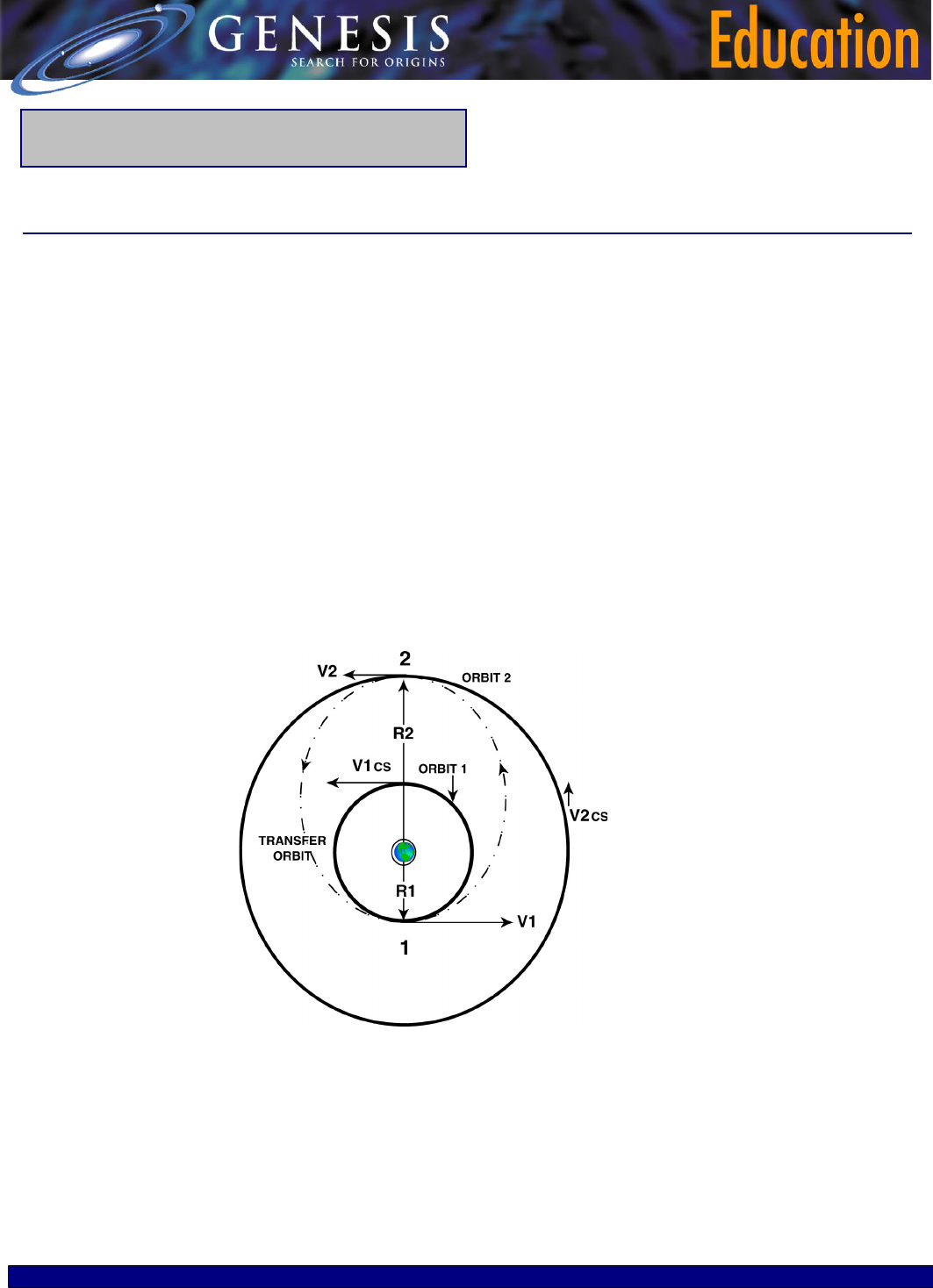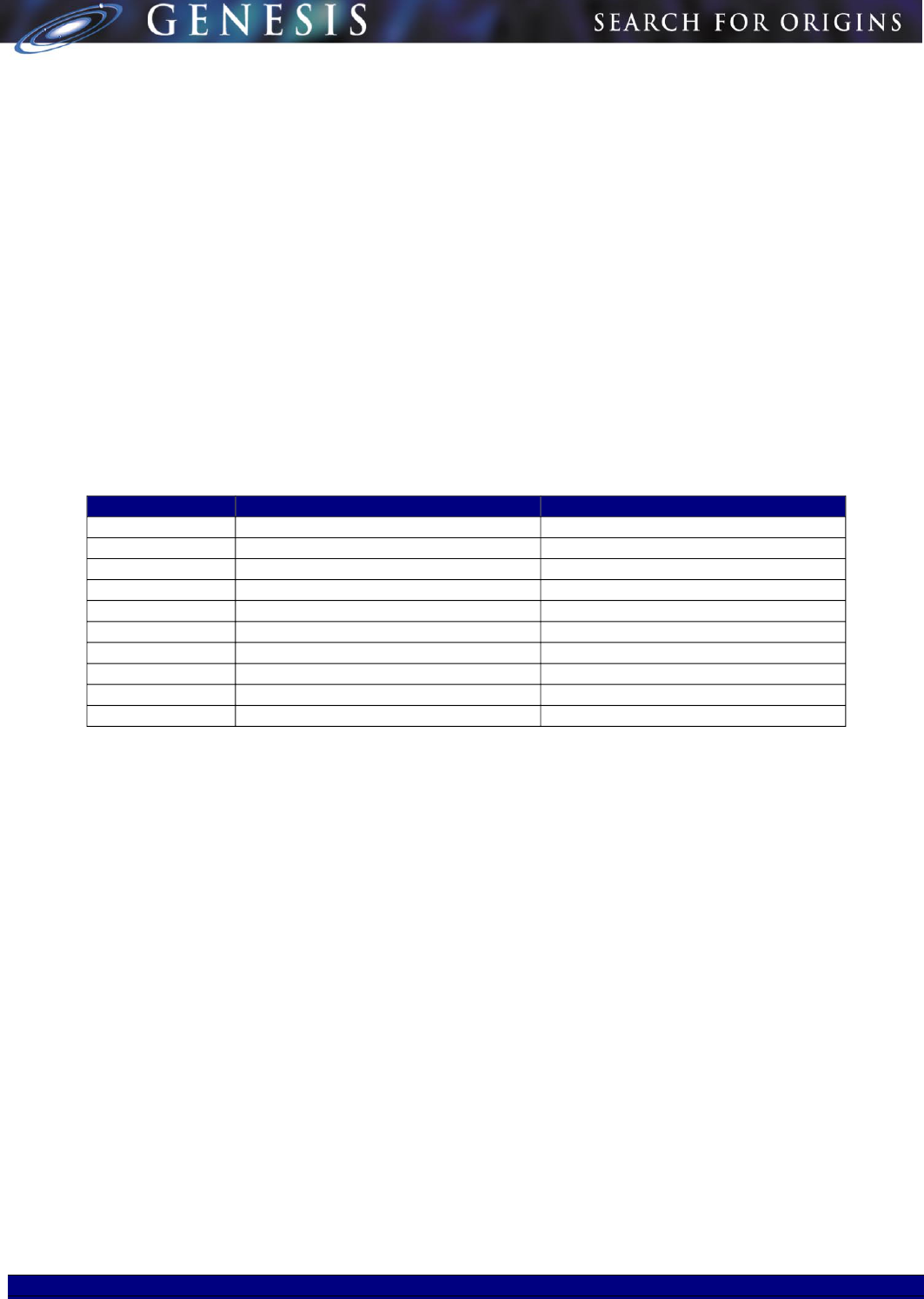
Destination L1: A Thematic Unit
Minimum Energy
Transfer Orbits
STUDENT ACTIVITY
BACKGROUND INFORMATION
This activity, named after Walter Hohmann, who developed it in 1925, provides an insight on how spacecraft can
move about our solar system. In this activity you will use a formula to calculate the time of flight that a spacecraft
would take using a Hohmann minimum energy transfer orbit. Once you have done the mathematics, you may use
an Excel spreadsheet to analyze these orbits with other planets and locations within the solar system. The Excel
spreadsheet is a tool that is used to produce some basic parameters of minimum energy orbits that will take you
from one body in the solar system to another. With this information, you can carry out a more detailed analysis to
design a space mission.
Observe the diagram below. First, let’s define some of the labels. “1” represents a planet (perhaps Earth); “2”
represents a second planet (perhaps Mars). Both of these planets are orbiting about a much more massive body
such as the sun. We will assume that both are in circular orbits. Planet 1 (1) is a distance of “R1” from the sun
and planet 2 (2) is at a distance of “R2” from the sun. In this case the R stands for radius. In elliptical orbits this is
known as the semi-major axis.
Planet 1 is moving at a speed of V1 in its orbit; planet 2 is moving at V2 in its orbit. To go from planet 1 to planet
2, or vice versa, we need to move along an elliptical orbit. We will make this journey with a minimum amount of
energy—using the least amount of fuel.
THE EQUATIONS
The time it will take to travel along the transfer orbit from planet 1 to planet 2, or vice versa, will be called “travel
3
time.” A derivative of Kepler’s Third Law (P
2
= k x a ) can be used to calculate travel time. In this case, “P” is
equal to the orbital period of the planet or the time it will take to travel along the transfer orbit; “a” is equal to
(R1+R2)/2, or the average of the sum of the two orbital radii (semi-major axis); and k is a constant.
1STUDENT ACTIVITY: TRANSFER ORBITS GENESIS

Body Average Distance from the Sun (AU) Average Distance from the Sun (k
First, let’s find the average sum of the two orbital radii of Earth and Mars.
a = (R1+R2)/2
a = distance of sun to Earth + distance of sun to Mars divided by 2
a = (1.000 AU + 1.524 AU)/2
a = 1.262 AU
Next, we will use the “a” value to find the time of flight from Earth to Mars using a Hohmann minimum energy
transfer orbit. Remember “P” squared in years is proportional to “a” cubed measured in AU. Using Kepler’s Third
Law, Walter Hohmann determined the formula for calculating transfer orbits for circular orbits. We divide by 1 AU
because this represents the circular radius of Earth’s orbit. k is equal to 0.5 when the unit for time is in years and
the unit for distance is AU.
P2 = k x a
3
AU/1 AU
P = k x a
3/2
AU/1 AU
P = 0.5 (1.262 AU)
3/2
AU/1 AU
P = 0.709 years
TABLE OF PERIODS FOR ORBITS OF SOME BODIES IN SPACE
Body Average Distance from the Sun (AU) Average Distance from the Sun (km)
Mercury 0.387 5,790,758
Venus 0.723 10,818,394
Earth 1.000 149,632,000
Mars 1.524 227,988,770
Jupiter 5.203 778,496,460
Saturn 9.555 1,429,705,900
Uranus 19.191 2,871,604,300
Neptune 48.445 7,248,969,300
Pluto 39.530 5,914,952,960
Other
Use the equations and table above to find the travel time using a Hohmann minimum transfer orbit for a trip from
Earth to Venus. Use the space provided below to show your work.
2STUDE NT ACTI V ITY: TRAN SFER O RBITS G E NE SIS

TECHNOLOGY APPLICATION:
Use the following information to find the Hohmann minimum transfer orbits from the Earth to other places in the
solar system. The following is how to use a pre-programmed Excel spreadsheet.
1. Open up the workbook (you can double click the file name of Hohmann.xls). The first column gives the
names of the planets. The last row has the name “other.” This is to allow one to experiment in transferring to
some location other than a planet, e.g., an asteroid; however, you will have to find out the bodies’ average
distance from the sun. The second column gives the average distance from the sun in “Astronomical Units,”
(AUs). This unit of measure is one average distance of the Earth from the sun, as illustrated by Earth with a
distance in AUs of 1.000. The third column gives this distance in kilometers.
2. Investigate the transfer orbits from Earth to all the other planets. To do this, take the value of the distance
from the sun for the Earth from column three, 149,632,000 km. Enter this number into the first row of column
four (D) “R1-Start Dist. From Sun.”
3. Now, use the pull down menu of “Tools,” then “Macro,” and then “Macros.” The macro window will come up
with “Hohmann” highlighted. Click “Run.” The rest of the spreadsheet will fill in using the equations shown
above. (You can look at the macro by using “Edit” to see the listing and how the equations are solved.)
The headings of the columns are self-explanatory, but to be sure Column 9 (I) “R1 Body Orb. Vel (km/sec)” is
the velocity in its orbit of the body we are leaving from—in this case, the Earth. Column 10 (J), “2
nd
Body Orb.
Vel (km/sec) shows the velocity of all the other bodies in their orbits. Column 12 (L), “1. Orbit Trans. Vel
(km/sec),” is the velocity you must get your spacecraft to obtain to get you traveling along the transfer orbit. If
you want to get to a body closer to the sun than Earth, you actually slow down from the orbit speed. To get to
a body farther out than your starting point, you must add to the orbital velocity. Column 14 (N), “2. Orbit Trans
Vel (km/sec)” is the velocity your spacecraft will be going as it moves along the elliptical transfer orbit when it
gets to the spot in space that meets the path of the circular orbit of the body you are traveling to. Compare
this to the number in Column 10 to see what you need to do with your spacecraft to transfer into the orbit of
the 2
nd
body. You must either increase or decrease your spacecraft velocity just as you are tangential to the
orbit of the 2
nd
body to match its speed in its circular orbit.
Columns 16 (P), 17 (Q), and 18 (R) give you the time of flight from the starting body to the second body in
different units (sec, days, and years).
The data for the Earth-to-Earth do not really seem to make sense until you realize what you are doing is
positioning yourself 180 degrees from where you are around the sun. It will take one half an Earth-year to do this.
4. Use the spreadsheet that has the transfer orbits from Earth to all the other planets that you created above to
answer the questions on the student reporting sheet.
A FINAL IMPORTANT NOTE
The actual “mission planning” done by the “space navigators” must be much more exact and accurate than the
simple model we have used. The planets are not exactly in circular orbits; we often move along a transfer orbit
that is not minimum energy; we often decide what day we want to get to a planet because of sun conditions; and
we often use “gravity assist,” etc. With all this said, our simple calculations will give you a very good estimate of
the flight parameters. In comparison during the Magellan mission to Venus, these simple equations predicted the
time of flight within several days.
3STUDENT ACTIVITY: TRANSFER ORBITS GENESIS

•
i l
•
i ill
•
i
imi i
i ill i i
si i
i i
li i ∏ R
2
).
l i l
i i l gi i
i i
l ill
i l i i
i
i
ill iti it
ill
j
i l
EXTENSION ACTIVITIES
Experiment starting your transfer orb t from Mars, Venus, Mercury, and all the other planets. Does the trave
time (T) match what you expected?
Look up the orbit of an asteroid (you will need to assume it is a c rcular orbit). See how long it w take to get to
it from Earth.
Your spreadsheet will give you the time it takes to get to the orb t of the body you are traveling to, but will the
body be there when you get there? You are a ng at a “mov ng target.” When you launch, the second body
must be in a locat on such that it w take the travel t me per od to the point of intersection. That way it will be
there when you are. How can you calculate the positions of the two bodies when you launch? Here is one
mple, “first princ ples” approach.
1. Use the information in Column 3 (C) to calculate the c rcumference of the second orb t of body 2,
the body you are trave ng to (remember c rcumference =
2. Multiply the value of Co umn 14 (N) t mes the trave time (sec) given in column 16 (P) (remember
distance = rate X t me). Th s wil ve you the distance in k lometers; the second body will travel
along its orbit during the transfer from the f rst body to the pos tion of the second orbit.
3. For the second body to travel exact y once around the sun, it w sweep out an angle of 360
degrees around the sun.
4. Set up a fraction with the numerator the d stance the second body trave s dur ng the t me of flight
and the denominator the c rcumference of the orbit of the second body.
5. Multiply this fract on times 360 to see how many degrees ahead of the intersection point the second
body must be when you launch.
6. Body 1 w be at a pos on 180 degrees from the intersection point of the transfer orbit and the orb
of the second body.
7. Look up the positions of the two bodies in the solar system to determine when you w be able to
make this ourney.
8. Approx mate y how often can we travel from the Earth to Mars?
4STUDENT ACTIVITY: TRANSFER ORBITS GENESIS
